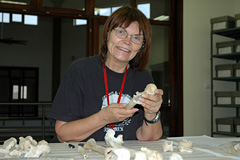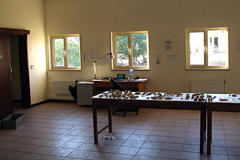- Activities >
- Archaeological Anthropology >
- Archaeological Anthropology at Kaman-Kalehöyük
Report on Work during 2009 Season at Kaman-Kalehöyük
by Veronica Hunt, London UK

Veronica at work in the new lab.
I worked at Kaman Kalehöyük from 4th - 18th July, 2009. During that period I first moved into my new work facilities at the Institute, and then went on to analyse remains from the Assyrian Period, which had only been briefly investigated in earlier seasons. Most, but not all, of this material is burnt, to varying degrees, and fragmentary, although there are exceptions (see below). Due to the sheer amount of material from this level and its difficult condition, it was not possible to finish the period, and the work will be continued at a later date.
All material processed this year was excavated in 1994. It came from a total of three locations, all of them from the North Area. The first and largest collection of remains was from a multiple deposit, where a total of 10 individuals were represented, ranging from a largely complete skeleton of an adult male to a couple of fragments from a neonate. Several of the individuals had apparently been thrown into position, face down. This raises interesting questions about burial practices during this period, which will need further investigation.
In contrast to this group, the second largest assemblage was a burnt one, where the individuals had been found lying on the floor in a room. The remains were highly fragmented and commingled, but it was possible to do a count and establish rough age ranges.

Part of the new Anthropology lab.
The final location contained one adult male, in excellent condition, found lying on his back. He had, before he died, received a blow to the forehead, which had begun to heal.
Results of this season's work will be published in the next issue of the journal, in the usual manner.
The spacious new laboratory made it possible to teach others, and during my stay I supervised two zooarchaeology students, who worked with me on sorting the burnt fragments mentioned above, and two conservation students worked on refitting a collapsed cranium. I hope to have the opportunity to do more "field style" teaching in the coming seasons.